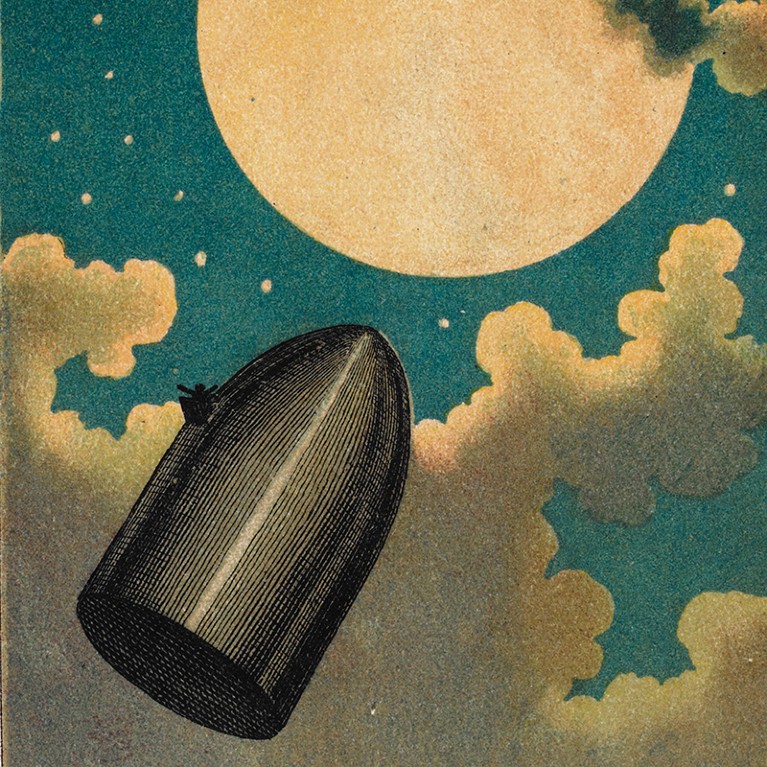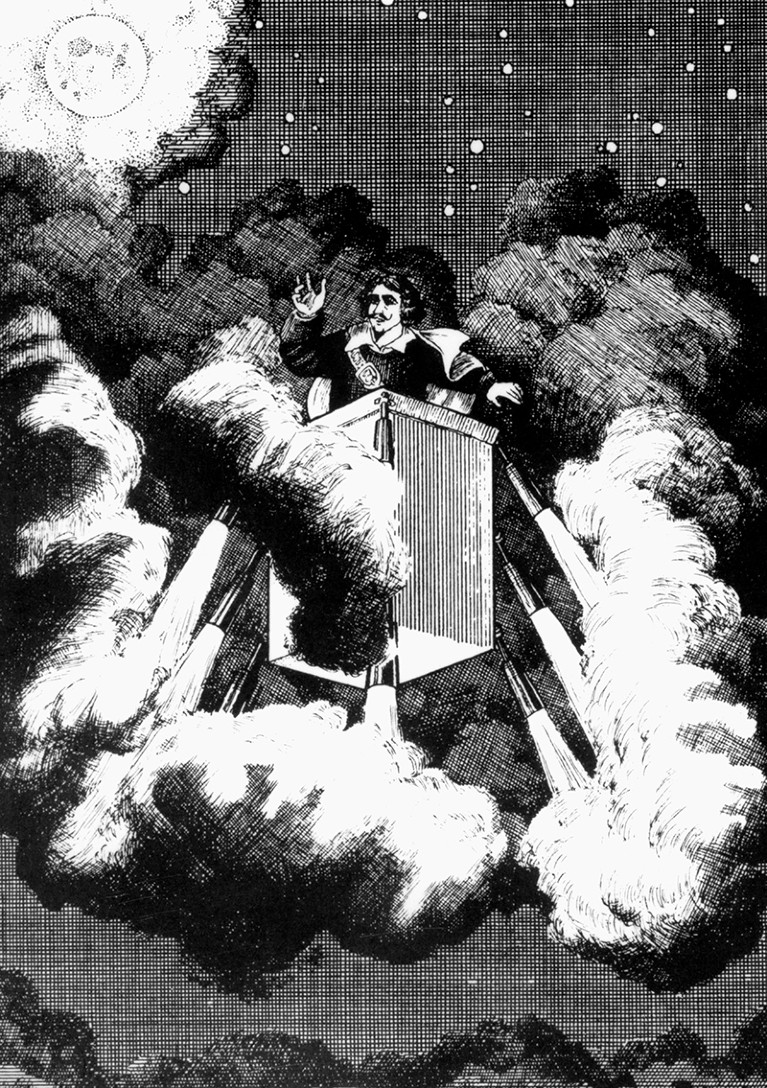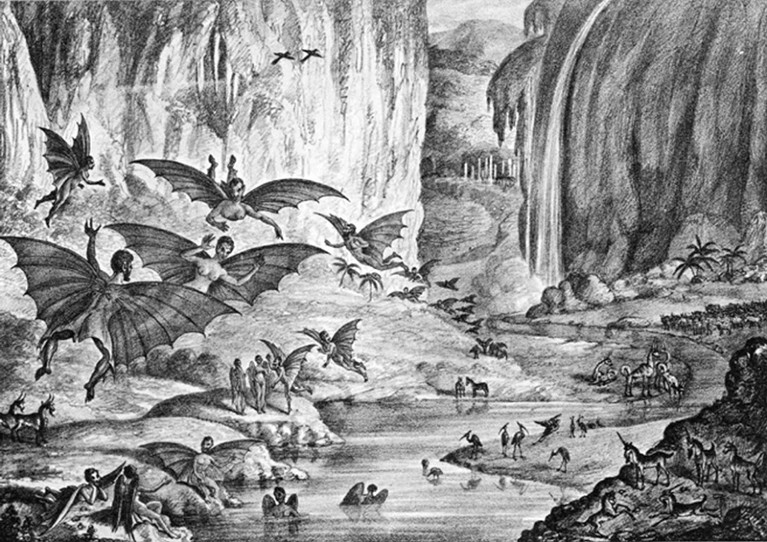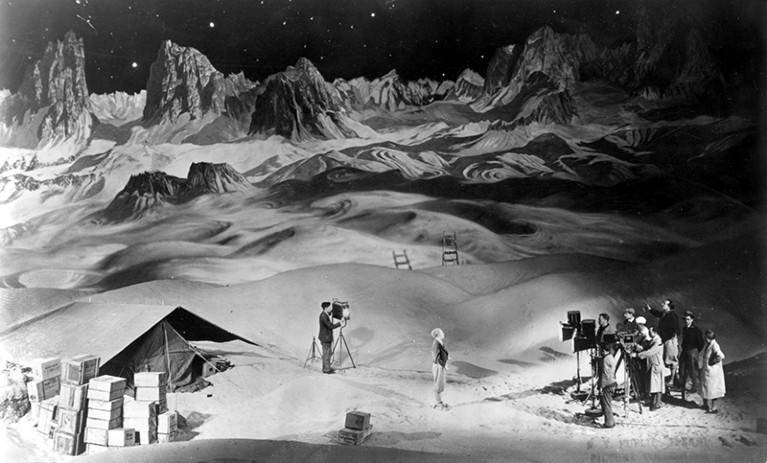
An illustration from Jules Verne’s 1865 novel From the Earth to the Moon.Credit: Heritage Image Partnership/Alamy
The Moon’s luminous, cratered face, visible to the naked eye, has sparked the imaginations of writers and scientists for centuries. Our satellite became a blank canvas: a proxy Earth on which writers could project alternative societies and satirize terrestrial ones, and a fruitful testing ground for scientific and technological speculation.
One lunar-literature pioneer was the second-century Syrian satirist Lucian of Samosata, whose A True Story is often cited as the first science-fiction narrative. Extrapolating from sea voyages, travellers are blown to the Moon by a whirlwind. In a satire on Earthly territorial conflicts, they encounter a war between Sunites and Moonites. Lucian’s Moon-dwellers are tall humanoids dressed in woven glass and subsisting on frogs.
Greek biographer Plutarch’s Moralia (ad 100) is arguably the first such narrative to introduce scientific ideas. It contains a dialogue that could be construed as early astronomy, touching on close observation of the lunar surface and its appearance at different phases of orbit.
Nature special: 50 years since the Apollo Moon landing
Lunar literature began to crystallize in the ferment of the Renaissance, and to surge in the seventeenth century. The stimuli were Galileo Galilei’s lunar observations and championing of heliocentricism, and the encounters of imperial voyagers with the lands and peoples of the Americas. German astronomer Johannes Kepler, for instance, predicted that the perfection of flight could lead to colonization of the Moon. His Somnium, published in 1634 and influenced by both Lucian and Plutarch, frames its narrative as a dream Kepler has about an Icelandic boy called Duracotus. Transported out of Earth’s gravitational field by a daemon, Duracotus travels to the island of Levania (the Moon), peopled with beings “of a monstrous size”. Here, he explores the two lunar hemispheres and gains new perspectives on Earth, revealing Kepler’s mastery of Copernican astronomy.
Flights of fancy
Kepler’s framing is followed by English historian Francis Godwin in The Man in the Moone (1638), purportedly an account by Spanish fugitive Domingo Gonsales, who is carried Moonwards by an imaginary species of wild swan (“gansas”). Aerial views of Earth are punctuated by scientific speculation about light, planetary motion and the Moon’s “attractive power”. Godwin’s utopian aliens communicate through “tunes and strange sounds”. More importantly, his narrative assimilates aspects of the new astronomy, such as the orbits of celestial bodies. The Moon was becoming a world in its own right.

Cyrano de Bergerac aims for the Moon in a firework-powered machine.Credit: Interfoto/Alamy
Several decades later came French writer Cyrano de Bergerac’s The Other World: Comical History of the States and Empires of the Moon (also called A Voyage to the Moon, 1657). In it, a fictionalized Cyrano attempts to reach the Moon wearing vials full of dew in a bizarre attempt to harness solar power. When that fails, fireworks attached to his “Machine” — a primitive rocket — do the trick. During his sojourn among yet more lofty Lunarians, Cyrano hears about magnetized flying devices, and even observes the use of audiobooks. And, like Jonathan Swift’s Gulliver in Brobdingnag, he is interrogated about his culture by his hosts so intensively that he begins to doubt his own human identity.
Through such dislocation, the Moon narrative became a reframing of Earth — an anthropologically tinged lens on the whole of humanity. In English novelist Daniel Defoe’s The Consolidator (1705), the protagonist travels to the Moon in a feather-covered chariot. He finds a culture that has perfected a range of optical instruments. Using lunar “Glasses”, he perceives both this new world and the limitations and failings of Earthly society.
A Voyage to Cacklogallinia (1727), by the pseudonymous ‘Captain Samuel Brunt’ (real identity unknown), features beautiful Moon-dwellers called Selenites who offer Brunt wisdom rather than material riches, parodying financial-speculation scams such as the 1720 South Sea Bubble.
Colonial parables
The South Sea Company, the enterprise behind the ‘bubble’, was entangled in the cruelties of the Atlantic slave trade. Realities of empire inevitably seep into eighteenth- and nineteenth-century lunar literature. US writer Washington Irving drew on lunar writing to insert an anti-imperialist parable into Knickerbocker’s History of New York (1809). After outlining Europeans’ first brutal contacts with Native Americans, he invites readers to consider an invasion from a lunar people skilled in the “art of extermination”, against which Earthlings have no defence.
The colonialist presumption that contact will spark conflict is questioned by US writer George Fowler in his 1813 A Flight to the Moon. Here, space traveller Randalthus is astonished to find that Lunarians are much like Earthlings. He peaceably shares insights on eclipses and the physical Moon, an exposition of astronomy that leaves his audience in awe of this “expounder of the laws of nature”.

An 1835 article in New York newspaper The Sun claimed that winged humanoids lived on the Moon.Credit: New York Sun
Increasingly, lunar literature wove in scientific advances reported by the media. In 1835, two Moon-based hoaxes exploited this relationship. In one, journalist Richard Adams Locke wrote and published six articles in New York newspaper The Sun. These were heralded as “great astronomical discoveries” — purportedly reprints of findings published in the Edinburgh Journal of Science by the renowned astronomer John Herschel. Packed with technical details about Herschel’s new telescope, they combine descriptions of lunar terrain with supposed sightings of “brown quadrupeds” and winged humanoids.
Science fiction: Verne and beyond
The other hoax, published by Edgar Allan Poe in the periodical Southern Literary Messenger, was ‘The Unparalleled Adventure of One Hans Pfaall’. Framed as a news report, it describes a journal by the fictional Pfaall, recording a voyage to the Moon in a balloon equipped with a machine that compresses the vacuum of space into air. There are brief glimpses of Earth and a volcanic Moon, and “ugly little people” in a lunar city. But Pfaall’s promised scientific revelations are never divulged, for disturbing in-story reasons.
Technology and tensions
Three decades later, French writer Jules Verne nodded to the growing body of lunar literature as the “romance of the Moon” in his novel From the Earth to the Moon (1865). Along with modern touches such as financial backing for the flight, the technological and scientific detail was ambitious. The story hinges on a vessel, the Columbiad, launched to the Moon from a super-cannon in Florida. (An 1880 review in The Pall Mall Gazette coined the term space-ship to describe it.) Verne made detailed calculations of its angle and velocity, subsequently mocked by Arthur C. Clarke in his foreword to a 1993 edition of H. G. Wells’s 1901 The First Men in the Moon.
The latter avoided number-crunching, instead positing an anti-gravity substance, cavorite, capable of propelling a spherical steel vessel Moonwards. The two astronauts, Bedford and Cavor, encounter Selenites, intelligent insectoid beings that dwell underground and wear helmets and glasses. Like bees, they are eusocial: they have a bewildering array of different forms and a single monarch, the Grand Lunar.

Director Fritz Lang filming Woman in the Moon in 1929.Credit: Everett Collection/Alamy
A return to rocketry is seen in German writer Thea von Harbou’s 1928 novel The Rocket to the Moon, describing a quest for lunar gold backed by unscrupulous businessmen. The book was adapted by Fritz Lang for his 1929 film Woman in the Moon. In a tangle of fact and fiction, the film inspired aeronautical engineer Wernher von Braun, who later co-wrote the non-fiction work The Conquest of the Moon (1953). This describes how existing infrastructure could enable the assembly of Moon-ships next to a space station by 1978.
Beyond pulp: trailblazers of science fiction’s golden age
By the 1950s, our satellite was doing regular service as a surrogate Earth where political issues of the era played out. In science-fiction luminary Robert A. Heinlein’s juvenile novel Rocket Ship Galileo (1947), three teenagers explore the Moon and reveal a secret camp of Nazi fugitives, along with traces of nuclear explosions. Clarke’s Earthlight (1955) also dramatized cold-war tensions, in an opposition between planetary settlements and a centrally controlling Earth.
The difference was that Clarke — a physicist as well as a writer — packed his text with data on the Moon’s atmosphere and gravity. Behind his narrative lies an account of how scientific analysis and discovery constantly modify or reverse preconceptions about colonizing the Moon. Indeed, he implicitly aimed to demonstrate space travel’s feasibility in his novel Prelude to Space (1951), which presents a quasi-scientific account of mounting a Moon mission. Within two decades, Clarke’s hopes had been realized.
Although the Apollo programme seemed a one-off for decades, it lent plausibility to the idea of colonizing space. Since 1969, that theme has played out in science fiction from the likes of Ursula K. Le Guin, Nalo Hopkinson, Pamela Sargent, Kim Stanley Robinson and many others — and has reignited national interest in the real thing. Our lunar dreams have not abated.


 Nature special: 50 years since the Apollo Moon landing
Nature special: 50 years since the Apollo Moon landing
 Propulsive reading: books on the Moon
Propulsive reading: books on the Moon
 These young scientists will shape the next 50 years of Moon research
These young scientists will shape the next 50 years of Moon research
 First Moon landing was nearly a US–Soviet mission
First Moon landing was nearly a US–Soviet mission
 Cancer, climate, plastics: why ‘earthshots’ are harder than moonshots
Cancer, climate, plastics: why ‘earthshots’ are harder than moonshots
 Can NASA really return people to the Moon by 2024?
Can NASA really return people to the Moon by 2024?
 Beyond pulp: trailblazers of science fiction’s golden age
Beyond pulp: trailblazers of science fiction’s golden age
 Ursula K. Le Guin: an anthropologist of other worlds
Ursula K. Le Guin: an anthropologist of other worlds
 The worlds of H. G. Wells
The worlds of H. G. Wells
 Science fiction: Verne and beyond
Science fiction: Verne and beyond






